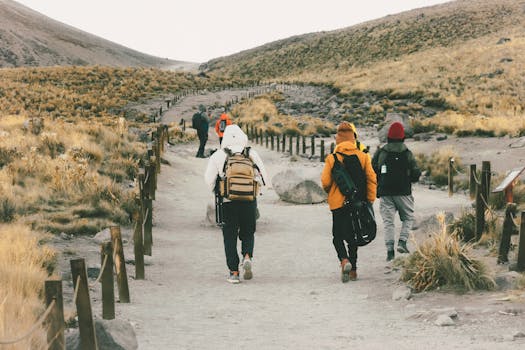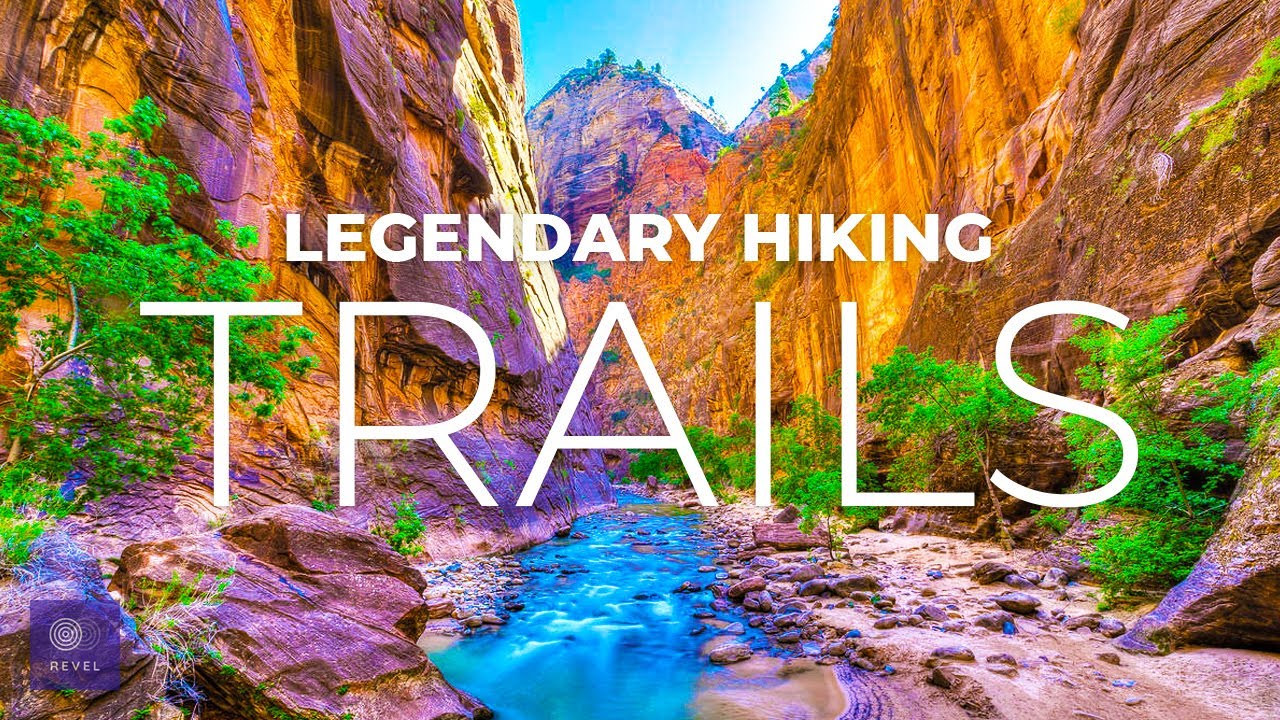Are you ready to embark on a breathtaking adventure through nature’s wonders? Hiking is not just a way to exercise and stay fit, but also a way to connect with the great outdoors, soak in the beauty of untouched landscapes, and rejuvenate your mind and soul. Whether you are an experienced hiker or new to the trails, there are endless opportunities to explore some of the best hiking trails around the world. In this article, we will take you on a virtual journey to discover the most iconic and scenic hiking trails, as well as provide you with essential tips and guidelines to enhance your hiking experience. So lace up your hiking boots, grab your backpack, and let’s hit the trails!
Choosing the Right Trail
When it comes to choosing a hiking trail, there are several factors to consider. One of the most important considerations is the trail difficulty level. Hiking trails are typically classified into three main categories: easy, moderate, and difficult. It’s important to assess your fitness level and choose a trail that matches your capabilities. Starting with an easy trail is a great way to build confidence and gradually increase the difficulty level as you gain experience.
Another factor to consider is the length of the trail. Are you looking for a short day hike or a multi-day adventure? The length of the trail will determine the amount of time you need to set aside for your hike. It’s important to plan accordingly and allocate enough time to enjoy the journey without feeling rushed.
Location is another crucial factor to consider. Do you prefer hiking in the mountains, along the coastline, or through dense forests? Consider the scenery you want to experience and select a trail in an area that aligns with your preferences. Additionally, take into account the weather conditions and accessibility of the trail. Some trails may be closed during certain seasons or require special permits, so be sure to do your research beforehand.
Top Hiking Trails Around the World
-
Inca Trail (Peru):
- The Inca Trail is one of the most famous and iconic hiking trails in the world, leading to the ancient ruins of Machu Picchu. This 26-mile trail takes hikers through the breathtaking landscapes of the Andes Mountains, passing through cloud forests, high mountain passes, and Inca ruins along the way. The highlight of the trail is reaching the Sun Gate, where hikers are rewarded with their first glimpse of the magnificent Machu Picchu.
-
Appalachian Trail (USA):
- Stretching over 2,200 miles across 14 states, the Appalachian Trail is a true hiker’s paradise. It offers a wide range of terrains and landscapes, including wooded valleys, rocky peaks, and stunning vistas. Whether you choose to tackle a small section or complete the entire trail, the Appalachian Trail promises an unforgettable experience.
-
Camino de Santiago (Spain):
- The Camino de Santiago, also known as the Way of St. James, is a pilgrimage route that has been traveled for centuries. The most popular route, the Camino Francés, starts in the French town of Saint-Jean-Pied-de-Port and ends in Santiago de Compostela. Hikers can choose to complete the entire 500-mile journey or opt for shorter sections. Along the way, they will pass through picturesque villages, historic sites, and beautiful countryside.
These are just a few examples of the countless incredible hiking trails around the world. Each trail offers a unique experience and a chance to immerse yourself in the beauty of nature. So, whether you’re drawn to the ancient ruins of Machu Picchu, the rugged beauty of the Appalachian Mountains, or the spiritual journey of the Camino de Santiago, there’s a trail out there waiting for you.
Best Hiking Trails in North America
North America is home to some of the most breathtaking hiking trails that cater to various fitness levels and preferences. Let’s take a closer look at a couple of these trails:
-
Pacific Crest Trail (USA):
- The Pacific Crest Trail stretches over 2,650 miles from Mexico to Canada, traversing through three states: California, Oregon, and Washington. This long-distance hiking trail offers hikers an opportunity to witness the diverse landscapes of the western United States, including deserts, forests, and mountain ranges such as the Sierra Nevada and Cascade Mountains.
-
Grand Canyon Rim-to-Rim Hike (USA):
- For those seeking a challenging and awe-inspiring adventure, the Grand Canyon Rim-to-Rim hike is a must-do. This 21-mile hike takes you from the North Rim of the Grand Canyon to the South Rim, allowing you to witness the grandeur of one of the world’s most famous natural wonders up close. The trail provides breathtaking views of the canyon, but be prepared for steep descents and ascents.
These are just two examples of the incredible hiking opportunities available in North America. From the rugged landscapes of Alaska to the stunning coastal trails of California, the continent is filled with endless possibilities for outdoor exploration.
Safety Tips for Hiking
While hiking offers a thrilling adventure, it’s important to prioritize safety to ensure an enjoyable experience. Here are some essential safety guidelines for hikers:
-
Pack the essentials:
- Before hitting the trail, make sure you have the necessary items, including a map, compass, first aid kit, extra food, water, and appropriate clothing for the weather conditions. It’s important to be prepared for any situation that may arise during your hike.
-
Stay hydrated:
- Drinking enough water is crucial to prevent dehydration, especially on longer hikes or in hot weather. Carry an adequate supply of water and make sure to drink regularly throughout your hike.
-
Be aware of wildlife:
- While encountering wildlife adds to the excitement of a hike, it’s important to keep a safe distance and avoid disturbing or feeding the animals. Research the wildlife in the area and educate yourself on how to respond if you come across a potentially dangerous animal.
-
Leave no trace:
- Hiking responsibly means leaving the trail and surrounding nature as you found it. Pack out all trash, avoid disrupting plants and wildlife, and stay on designated paths. Respecting the environment ensures that future hikers can enjoy the trail as well.
Remember, safety should always be a priority when hiking. By following these guidelines, you can have a safe and enjoyable experience on the trails.
Benefits of Hiking
Hiking offers numerous physical, mental, and emotional benefits. Here are some of the ways spending time in nature and exploring scenic hiking trails can enhance your well-being:
-
Physical fitness:
- Hiking is a great way to stay active and improve your cardiovascular health. It helps strengthen muscles, improve balance, and increase endurance. The varying terrain and inclines provide an excellent workout for the whole body.
-
Mental and emotional well-being:
- Being surrounded by nature and disconnecting from the hustle and bustle of daily life can have a positive impact on mental health. Hiking allows you to clear your mind, reduce stress, and improve your mood. The sights and sounds of nature can be incredibly calming and rejuvenating.
-
Connection with nature:
- Hiking allows you to connect with the natural world on a deeper level. You have the opportunity to witness the beauty of untouched landscapes, observe wildlife in its natural habitat, and appreciate the wonders of the great outdoors. This connection with nature can foster a sense of awe, gratitude, and overall well-being.
-
Social engagement:
- Hiking can be a social activity that allows you to spend quality time with family and friends. It offers a chance to bond, share experiences, and create lasting memories together.
These benefits make hiking a wonderful activity for individuals of all ages and fitness levels. It’s not just about the physical exercise, but also about nurturing your mind and soul through a connection with nature.
Gear and Equipment
Having the right gear and equipment is essential for a successful hiking trip. Here are some items that should be on your hiking checklist:
-
Proper footwear:
- Invest in a good pair of hiking boots or shoes that provide ankle support and have a sturdy sole. Choose footwear that is comfortable and suitable for the terrain and weather conditions you will be hiking in.
-
Clothing layers:
- Dress in layers to accommodate changing weather conditions. Start with a moisture-wicking base layer, add insulating layers for warmth, and top it off with a waterproof and breathable outer layer if necessary.
-
Navigation tools:
- Carry a map and compass, or consider using a GPS device or smartphone app that provides detailed trail maps. It’s important to have a reliable means of navigation to ensure you stay on track.
-
First aid supplies:
- Pack a basic first aid kit that includes items such as bandages, antiseptic wipes, adhesive tape, pain relievers, and insect repellent. It’s always better to be prepared for minor injuries or medical emergencies.
When choosing your gear and equipment, consider the specific requirements of the trail you will be hiking. Research the weather conditions, terrain, and any additional gear or equipment recommendations for that particular trail.
Hiking Etiquette
Responsible hiking includes following proper trail etiquette. Here are some important practices to keep in mind when hitting the trails:
-
Yield to other hikers:
- When encountering other hikers on the trail, yield to those going uphill or hikers with children or pets. Step aside and give them plenty of space to pass.
-
Minimize noise pollution:
- Keep noise to a minimum to maintain the peaceful ambiance of the trail. Avoid loud conversations, playing music without headphones, or using noisy equipment.
-
Follow trail rules and regulations:
- Respect any specific rules or regulations posted on the trail. This may include restrictions on camping, fires, or other activities. Adhering to these guidelines helps preserve the natural environment and ensures everyone’s safety.
-
Respect wildlife and fellow hikers:
- Do not approach or feed wildlife, as this can disrupt their natural behavior and endanger both you and the animals. Be courteous and respectful to fellow hikers, and always be willing to lend a helping hand if needed.
By practicing these hiking etiquette guidelines, you can contribute to a positive and harmonious hiking experience for everyone involved.
FAQs
What should I pack for a day hike?
For a day hike, it’s important to pack the essentials such as a map, compass, extra food, at least one liter of water, appropriate clothing layers, a first aid kit, sun protection (hat, sunglasses, and sunscreen), and a small emergency shelter (such as a lightweight tarp or emergency blanket).
Are hiking poles necessary for all trails?

Hiking poles can be beneficial for certain trails, especially those with steep or uneven terrain. They provide added stability, reduce strain on your joints, and can assist with crossing streams or navigating tricky sections. However, they are not necessary for all trails and personal preference plays a role in deciding whether to use them.
How do I prepare for a high-altitude hike?

Preparing for a high-altitude hike requires gradual acclimatization to the altitude. Start by spending a few days at a lower elevation to allow your body to adjust. Stay hydrated, eat nutritious meals, and take it slow to avoid altitude sickness. It’s also important to have proper gear and clothing to protect against the cold and changes in weather that often accompany high-altitude hikes.
What are the best ways to stay safe while hiking alone?
When hiking alone, it’s crucial to take extra precautions to ensure your safety. Always inform someone of your hiking plans and expected return time. Carry a fully charged cell phone, a whistle or signaling device, and a personal locator beacon for emergencies. Stay on marked trails, be aware of your surroundings, and trust your instincts. It’s also helpful to educate yourself about the area you’ll be hiking in and the potential risks or hazards specific to that location.
Can I bring my dog on hiking trails?
Many trails allow dogs, but it’s important to check the trail regulations and guidelines beforehand. Some trails have specific rules regarding leashes, waste disposal, and areas where dogs are not allowed. It’s crucial to ensure that your dog is physically capable of hiking and well-trained to avoid any issues with wildlife or other hikers.
How can I prevent blisters while hiking?
To prevent blisters while hiking, it’s important to wear well-fitting and moisture-wicking socks that minimize friction. Break-in your hiking boots before embarking on a long hike and consider using blister prevention products such as moleskin or blister-specific bandages. Keeping your feet clean, dry, and well-maintained during your hike can also help prevent blisters.
Are there age restrictions for hiking certain trails?
While there are no specific age restrictions for hiking trails, it’s important to consider the difficulty level and length of the trail when hiking with children or elderly individuals. Ensure that the trail is suitable for their capabilities, and plan accordingly by taking breaks, carrying extra supplies, and monitoring their energy levels to ensure a safe and enjoyable experience for everyone.
What should I do if I encounter wildlife on a hiking trail?
If you encounter wildlife on a hiking trail, it’s important to keep a safe distance and avoid actions that may provoke or endanger the animal. Do not approach or attempt to feed wildlife. Give them space and observe from a distance. If the animal approaches you, speak calmly and back away slowly. It’s crucial to respect the natural habitat of the wildlife and prioritize their well-being.
How can I contribute to trail conservation efforts?
To contribute to trail conservation efforts, it’s important to practice Leave No Trace principles. This includes packing out all trash, staying on designated trails, being mindful of the plants and wildlife, and leaving natural and cultural features undisturbed. Additionally, consider volunteering for trail maintenance or joining local conservation organizations that work towards preserving and protecting hiking trails.
Conclusion: Final Take
Hiking offers a unique opportunity to disconnect from the modern world and immerse yourself in the wonders of nature. The scenic paths and breathtaking views found on the best hiking trails around the world allow you to explore untouched landscapes, challenge your physical limits, and rejuvenate your mind and soul. By choosing the right trail, prioritizing safety, respecting the environment, and being prepared with the necessary gear, you can embark on an unforgettable adventure that will leave you with lasting memories.
So, whether you prefer to trek through the Andes and witness the ancient ruins of Machu Picchu, conquer the rugged terrain of the Appalachian Mountains, or embark on the spiritual journey of the Camino de Santiago, there is a hiking trail out there waiting for you. Lace up your hiking boots, embrace the beauty of nature, and let the trails guide you to incredible experiences and a deeper connection with the world around you. It’s time to embark on your own hiking adventure and discover nature’s wonders on scenic paths.


